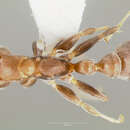en
names in breadcrumbs


Taxonomic history
Wheeler, 1905c PDF: 86 (q.m.); Wheeler & Bailey, 1920 PDF: 260 (l.); Wheeler & Wheeler, 1973d PDF: 207 (l.).Combination in Leptalea: Smith, 1951c PDF: 788.Combination in Pseudomyrmex: Wheeler & Wheeler, 1956 PDF: 384.Status as species: Smith, 1877b PDF: 61; Emery, 1890b PDF: 65; Forel, 1893j PDF: 390; Emery, 1895d PDF: 269; Forel, 1899b PDF: 88; Wheeler, 1905c PDF: 85 (redescription); Forel, 1906d PDF: 228; Forel, 1908a PDF: 65; Wheeler, 1910a PDF: 562; Wheeler, 1911a PDF: 22; Forel, 1911g PDF: 278; Forel, 1912h PDF: 23; Santschi, 1913h PDF: 36; Wheeler, 1913b PDF: 484; Wheeler & Mann, 1914 PDF: 18; Mann, 1916 PDF: 427; Wheeler, 1918b PDF: 24; Mann, 1920b PDF: 405; Emery, 1921c PDF: 32; Wheeler, 1922e PDF: 4; Menozzi, 1927c PDF: 267; Smith, 1930a PDF: 2; Wheeler, 1932a PDF: 4; Wheeler, 1934f PDF: 139; Menozzi, 1935b PDF: 191; Wheeler, 1935g: 16; Wheeler, 1942 PDF: 165; Creighton, 1950a PDF: 79; Smith, 1951c PDF: 788; Creighton, 1957b PDF: 18; Smith, 1958c PDF: 112; Wilson, 1964b PDF: 4; Smith, 1967a PDF: 348; Kempf, 1972b PDF: 217; Kempf & Lenko, 1976 PDF: 62; Smith, 1979: 1346; Ward, 1985b PDF: 227 (redescription); Ward, 1989a PDF: 419 (redescription); Deyrup et al., 1989 PDF: 94; Brandão, 1991 PDF: 375; Ward, 1992 PDF: 81 (in table); Bolton, 1995b: 372; Ward, 1999b PDF: 519 (redescription); Deyrup, 2003 PDF: 46; Wild, 2007b PDF: 40; Branstetter & Sáenz, 2012 PDF: 264; Bezděčková et al., 2015 PDF: 125; Deyrup, 2017: 41; Ward, 2019 PDF: 1103.Senior synonym of Pseudomyrmex allidora: Ward, 1989a PDF: 419; Brandão, 1991 PDF: 376; Bolton, 1995b: 372.Senior synonym of Pseudomyrmex alliodorae: Ward, 1989a PDF: 419; Brandão, 1991 PDF: 376; Bolton, 1995b: 372.Senior synonym of Pseudomyrmex elongata tandem: Creighton, 1957b PDF: 18; Kempf, 1972b PDF: 218; Smith, 1979: 1346; Ward, 1985b PDF: 227; Ward, 1989a PDF: 419; Bolton, 1995b: 372.Canindeyú , Central, Ñeembucú , Pte. Hayes, San Pedro (ALWC, IFML, INBP).
Pseudomyrmex elongatus is a species of ant in the family Formicidae.[1][2][3][4][5]
This is widely spread and common species from Mexico to Argentina. Long eyes, predominantly opaque head, small size (HW 0.56-0.68) these are some features of P. elongatus.
Pseudomyrmex elongatus is a species of ant in the family Formicidae.


This is widely spread and common species from Mexico to Argentina. Long eyes, predominantly opaque head, small size (HW 0.56-0.68) these are some features of P. elongatus.